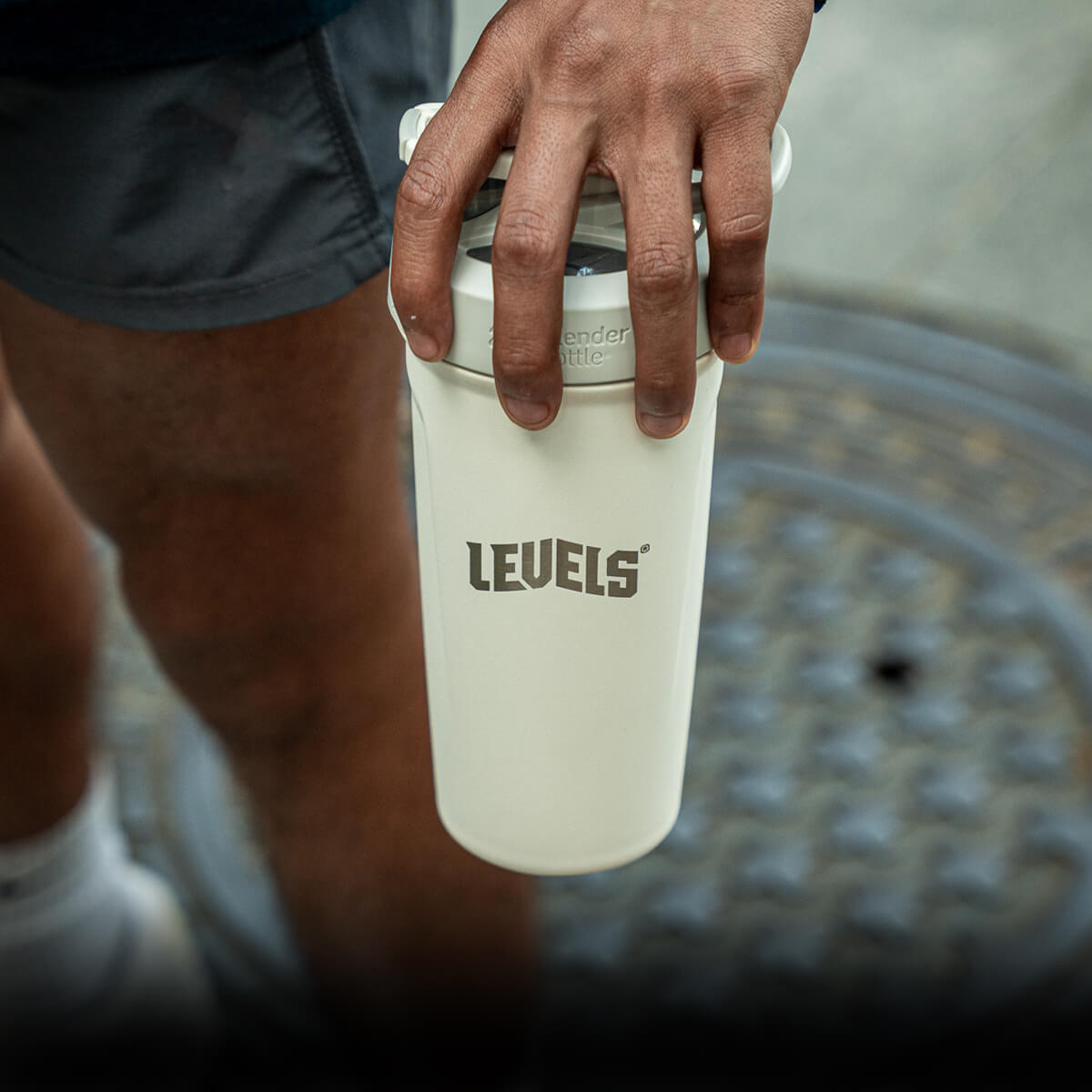Fasted cardio—exercising in a non-fed state, when your body isn’t digesting food—is a controversial topic.
On the one hand, some researchers in the field of endurance sports, and plenty of accomplished bodybuilders, are in favor of it.
But on the other hand, a few scientific studies claim fasted cardio is no more effective than fed cardio for fat loss. As a result, plenty of fitness enthusiasts dismiss it as “bro-science.”
Keep reading to find out more about fasted cardio, discover 4 impressive benefits of exercising on an empty stomach, plus learn how to put together your own fasted cardio plan.
What Is Fasted Cardio?
Fasted cardio refers to any type of cardiovascular exercise performed in a fasted state.
People typically use low-intensity aerobic exercise for fasted cardio.
And while using high-intensity interval training (HIIT) is technically possible, it’s probably not a good idea for reasons we’ll cover shortly.
The main reason people use fasted cardio is for fat loss, but some people also do it for potential health benefits.
So how long do you have to go without eating for your cardio session to be “fasted?”
Factors like meal size, time of day, macronutrients, and fiber content all affect your digestion rate[*].
But usually, it takes at most 5-6 hours for your stomach to empty, and the majority of a meal has passed through your small intestine after a total of 6-8 hours[*].
Therefore, waiting at least 6 hours after a meal is a safe bet to ensure you’re fasting and that you’ve fully digested your most recent meal.
And that’s why plenty of people perform fasted cardio before breakfast. Morning fasted cardio is an easy way to exercise on an empty stomach without adjusting your meal schedule.
Conversely, if you’re already “intermittent fasting,” you can do fasted cardio any time you aren’t eating. (Intermittent fasting is the popular name for any eating schedule that divides your day or week into periods of eating and fasting.)
And although no one knows for certain when fasted cardio originated, it’s safe to say that the practice goes back to prehistoric times. There is little doubt our ancestors hunted, ran, and performed other physical activities on an empty stomach.
Not only that, but bodybuilders have also used morning fasted cardio as a fat loss strategy for decades.
More recently, as the practice of intermittent fasting has gained popularity and scientific credibility, fasted cardio has also entered the mainstream.
In the next section, you’ll find out why fasted cardio is a controversial topic, and why not everyone thinks it’s a good idea.
Subscribe to get the latest advice, sales, discounts, product drops and more. Join now and get 15% off your first order.
Does Fasted Cardio Work?
People typically use fasted cardio for fat loss purposes. But does it work?
Some studies, such as a 2014 study of 20 women published in the Journal of the International Society of Sports Nutrition, have found no fat loss benefit for fasted aerobic exercise over fed aerobic exercise[*].

On the other hand, a 2009 study of 19 men fasting for religious reasons found a dramatic 6.2% decrease in body fat in men who performed cardio in a fasted state versus men who exercised fed[*].
Unfortunately, as with the examples above, most studies of this nature have a small sample size and short duration. These factors make drawing a conclusion from the existing data difficult.
Instead, let’s take a look at some basic science.
The Science of Fasted Cardio
Most people who dismiss fasted cardio use a “calories in, calories out” model for fat loss.
In other words, the main argument against fasted cardio is that it doesn’t matter when you do cardio, as long as you burn calories.
And while it’s true that a caloric deficit is essential to lose weight, “calories in, calories out” misses some major points about fat metabolism.
Additionally, if “calories in, calories out” was the best model for understanding fat loss, a “crash diet” without any exercise would be an effective way to lose fat.
For your body to burn stored fat, here’s what must occur:
- Lipolysis (where fatty tissue breaks down into free fatty acids (FFAs) that enter your bloodstream)[*]
- Transport of free fatty acids across cell membranes[*]
- Fat oxidation (in this case, the use of free fatty acids as fuel by muscle tissues)[*]
In other words, before you can burn stored fat, your body must break down the fat and transport it to cells, which then use it as fuel.
Otherwise, you’re still burning calories, but they’re not coming from stored fat.
That’s because eating food, in particular carbs, temporarily reduces your body’s ability to burn fat[*][*].
In contrast, fasted cardio maximizes the three fat-burning factors mentioned above:
- Lipolysis is highest when insulin levels are low, especially in a fasted state[*][*]
- Exercise (most of all aerobic exercise) and aerobic fitness increase the cellular transport of FFAs[*][*]
- The absence of carbs and insulin boosts fat oxidation (fat-burning) during exercise[*]
- Low-intensity cardio creates maximum demand for fat as a fuel, maximizing fat oxidation[*]
To sum up, fasting and cardio go together very well indeed.
It’s fair to say that fasting makes cardio more effective for using fat as a fuel, and that cardio makes fasting much more effective for burning fat, due to the increased calorie demand from exercise.
And although there isn’t a definitive study telling you fasted cardio is fantastic for fat loss and health, you can easily run your own experiment.
Downsides of Fasted Cardio
Are there any potential downsides to fasted cardio?
As a matter of fact, yes.
First of all, fasting does not maximize your cardio session performance. Therefore, if you’re competing, do it fed—not fasted.
Second, performing ultra-intense cardio (such as HIIT) fasted is unwise. The reason is because high-intensity cardio is glycolytic, meaning it relies on glucose (sugar) for fuel.
When you perform glycolytic activities fasted, especially when your muscles are already depleted of glycogen (stored glucose), you’re more likely to “crash.”
Additionally, overly intense cardio tends to increase amino acid oxidation, potentially resulting in the loss of muscle mass[*].

And last but not least, we don’t recommend doing weight training or “metcon” (metabolic conditioning) in a fasted state.
Resistance exercise is a dramatically different activity from cardio or aerobic exercise, and a fed state (with plenty of protein) is your best bet for maximizing lifting performance, muscle mass, and recovery.
4 Benefits of Fasted Cardio
1. Maximum Fat-Burning
When you fast, your blood sugar and insulin levels decrease compared to a fed state.
As a result, your body gains the ability to release, transport, and burn a much larger amount of stored fat—especially during exercise.
Under the right conditions, maximum fat oxidation during aerobic exercise ranges from about 1.3 to 1.5 grams of fat per minute[*].
Put differently, you could burn as much as 90 grams of fat per hour, or a full pound of additional stored fat after 5 cumulative hours of fasted cardio.
And not only that, but a 2017 study of young women also found that cardio before breakfast increased the participants’ fat oxidation rates for a full 24 hours[*].
2. Better Aerobic Fitness
For athletes, performing aerobic exercise in a fasted or zero-carb state may enhance fitness.

When you remove carbs from your cardio equation, your body becomes better at burning fat[*]. And increased fat-burning during aerobic exercise also equates to better performance.
Interestingly, if athletes train in a fasted or carb-depleted state consistently, they retain their increased fat-burning capability—even when eating carbs[*].
Bottom line: if you’re an athlete, try performing your aerobic training fasted. You may notice a boost in your work capacity and power output, even when exercising fed, such as during competitions.
3. Greater Metabolic Flexibility and Insulin Sensitivity
Metabolic flexibility is a term that describes what happens when your body switches between fuel sources, namely carbs and fats[*].
People who have poor metabolic flexibility also tend to store fat easily, have poor aerobic fitness, and experience difficulty fasting or skipping meals[*].
Fortunately, fasting and aerobic exercise both increase metabolic flexibility[*].
Essentially, if you get “hangry” frequently or have an unusually hard time losing weight, fasted cardio might be the perfect solution.
Also, insulin sensitivity is another health factor that relates to metabolic flexibility.
In a nutshell, insulin is a hormone that helps your body store sugar.
And when you have poor insulin sensitivity, you’re more likely to be obese, as well as suffer from conditions like type 2 diabetes, heart disease, and cancer[*][*].
However, fasting and cardio are both excellent ways to preserve or restore insulin sensitivity[*][*].
To sum up, fasted cardio might also help you prevent serious chronic diseases.
4. May Preserve Muscle Mass
As long as you don’t use excessive intensity, fasted cardio may be an effective strategy for preserving muscle mass during fat loss.
For example, according to the authors of a 2017 paper, aerobic exercise paired with diet preserved lean muscle mass 28% better than diet alone[*].

While it’s true that all forms of exercise increase muscle protein breakdown, eating a high-protein meal once you’re finished fasting or exercising makes up for this effect by boosting protein synthesis[*].
Also, fasting during cardio may even reduce muscle breakdown by increasing fat oxidation, thus sparing lean muscle mass[*].
Losing muscle mass during a fat loss phase is a serious concern, especially for bodybuilders and other muscular individuals. Fasted cardio is an excellent tool to burn more fat and lose less muscle mass.
Does fasted cardio burn muscle? For practical purposes, done correctly, the answer is absolutely not.
How to Perform Fasted Cardio
You’ve learned all about the science and benefits of fasted cardio. Now, here’s how to try it for yourself.
Fat Adaptation
If you’re experiencing fatigue, irritability, or excessive hunger during your sessions, you’re not fat-adapted yet.
Fasting, going keto, or following a low-carb or carb-cycling diet are all effective methods to improve your body’s ability to use fat as fuel.

But most of all, fat adaptation takes time, so be patient and don’t rush it. After 2-4 weeks of regular fasted cardio, you should notice significant improvements as well as positive results.
Frequency and Duration
Start with fasted cardio sessions 1-3 days per week, not on weight training days. You can gradually increase the frequency up to 4-5 days per week if you want.
At Levels, we don’t recommend fasting on strength training days, let alone fasted cardio on the days you’re lifting. If you want to fast daily, feel free, but it’s not the best way to progress in the weight room.
Also, for rapid fat loss, you can try two fasted cardio sessions on the same day during a single fast period. Just ensure that your diet is also dialed in, and remember to eat sufficient calories outside your fast periods.
Any duration of fasted cardio is potentially beneficial, but try to ensure your sessions are at least 20 minutes for best results.
And if you have the time, 45-60 minute sessions are optimal for most people. In some cases, 90-minute sessions or longer can work well, too.
Intensity
World-renowned endurance coach Phil Maffetone’s 180 formula is an easy way to calculate your heart rate for fasted cardio.
To use the 180 Formula, subtract your age from 180. Then, subtract additional points for each of the following:
- Medical condition or prescription drugs (10 points)
- Illness, injury, allergies, asthma, poor immune function, inconsistent or new to aerobic training (5 points)
For example, a 35-year old who is new to aerobic training (180-35-5) would end up with 140 beats per minute, while a 50-year old with a blood pressure prescription (180-50-10) would calculate 120 beats per minute.
Or, if you prefer not to take your pulse or use a heart rate monitor, a simpler method is to keep your intensity at or below the level at which you can say a full sentence with minimal difficulty[*][*].
If you can’t form a full sentence, reduce your intensity immediately.
Eating (And How Long to Wait)
If you’re not already using intermittent fasting, you can add fasted cardio right before breakfast, then eat as usual. Bodybuilders also favor this approach during bulking phases when they prefer not to fast for extended periods.
However, your fat loss results will probably be better if you extend the fast further. Consider experimenting with fasting an additional 2-8 hours after you finish your cardio session.
And keep in mind there’s no rule saying you must fast in the morning. If you’re fasting during the second half of the day or following another form of time-restricted eating, simply wait 6 hours after your final meal of the day to perform fasted cardio.
Also, your goals will determine the type of meal that’s best for breaking the fast.
If you’re planning on lifting early the next day, a protein and carb meal whenever you break your fast is an effective way to replenish glycogen and fuel your upcoming workout.
In contrast, if you aren’t planning on lifting, a protein and fat meal (with few or no carbs) can extend your fat-burning window after you’ve finished fasting.
Regardless of whether you choose carbs or fat, eating sufficient protein as you break your fast helps reverse any muscle protein breakdown[*].

The Bottom Line
Fasted cardio is an intelligent, effective way to derive additional benefits from intermittent fasting.
It can also maximize fat-burning, improve your aerobic fitness, and boost your overall health.
If you’re already fasting regularly, consider adding a few fasted cardio sessions each week during your usual scheduled fasts.
Or, if you haven’t tried fasting yet, simply add a few fasted aerobic workouts before breakfast on days you aren’t lifting weights. From there, if you like, you can gradually extend the fast periods.
Regardless of how you choose to implement it, fasted aerobic exercise is worth your time.
We’d love to hear about your personal experience with fasted cardio. Let us know your stories or questions in the comments!













